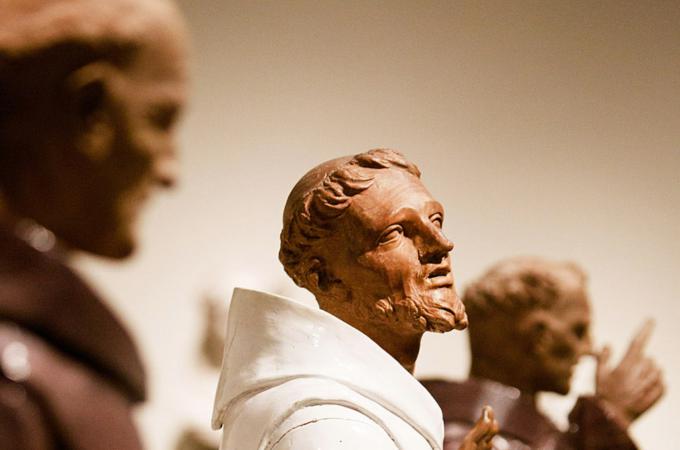MFA's Della Robbia exhibit explores faith through sculpture
BOSTON -- It all started with a sculpture in an attic.
Tucked away in a corner of the attic at the Museum of Fine Arts (MFA) sat a sculpture of St. John the Baptist, gifted to the museum by the late Mrs. Solomon Guggenheim. In 2003, when the museum embarked on a major building renovation, the attic was cleared and the sculpture surfaced.
St. John the Baptist "literally emerged from the attic," explained Marietta Cambareri, senior curator of European Sculpture at the MFA. Little was known of the terra cotta sculpture at the time. Looking for answers, Cambareri and museum conservator Abby Hykin, began a technical analysis of the piece. Their search sparked in Cambareri a desire to create an exhibit centered on a unique type of terra cotta sculpture created by the Della Robbia family in Florence.
"I guess you can say he (St. John the Baptist) was the beginning of this exhibit," she said.
"Della Robbia: Sculpting with Color in Renaissance Florence," now on display at the MFA, is the first exhibit of its kind in the United States. Featuring 46 works of art by the Della Robbia family and associates, it highlights a groundbreaking glazing process invented by Luca Della Robbia at the turn of the 15th century that is known for its vibrant color.
"These sculptures are extraordinarily durable. The colors do not fade or change over time," Cambareri said. "Truly, they knew that these colors were going to endure the test of time."
In order to bring together such an exhibit, sculptures were brought in from all around the world, including six pieces from Italy that have never been seen in the United States, Cambareri said.
Cambareri explained that the exhibit is divided into three sections, each based on one of the theological virtues of Hope, Love and Faith.
"In the Renaissance, these theological virtues permeated not just religious life, but also the social, familial, civic -- really every aspect of everyday life," she said.
The first section, Hope, can be summed up by a sculpture of a young boy, created by Andrea della Robbia circa 1475, on loan from the Museo Nazionale dei Bargelio. According to Cambareri, "children represented hope -- the hope of the future, the hope of the Church, the hope of the future of the family, the hope of the future of Florence."
Another piece in this section is "The Resurrection of Christ," which was originally commissioned by the Antinori family in the early 1500s, possibly for their private chapel. At the turn of the 19th century, it was sold to the Brooklyn Museum, which has loaned it to the MFA for this exhibit.
In the second section, Love, the focal piece is "The Visitation" -- a life-sized sculpture of the Virgin Mary visiting her cousin Elizabeth. Cambareri noted that this sculpture is entirely white because "in the renaissance, white evoked notions of purity, or joyfulness, and of love.
The sculpture is on loan from the Church of San Giovanni Fuorcivitas in the small Italian village of Pistoia. Cambareri explained that she had to call the parish priest, as well as the bishop of the region, to obtain permission to bring the sculpture to Boston.
"I began to think that if this sculpture comes, it will be a miracle," she said. "And seeing it here really does feel like a miracle."
"In the town of Pistoia it is behind an altar, covered in glass, in a dark church -- this is a rare opportunity to see the sculpture in its glory," she added.
In addition, another sculpture, entitled "Prudence," features a person with two faces -- one looking forward, the other looking back.
The third section, Faith, shows some difference to the other two. In the first two sections, the colors are vibrant -- white, cerulean, yellow, green. This section, which shows some of the later works of the della Robbia family, features three life-sized statues: St. Giovanni Capistrano, St. Francis of Assisi and St. Bernadine of Siena, with their faces unglazed.
"By 1550, when these were made, the material was falling out of favor among the people. Marble Sculpture and bronze sculpture were the norm," explained Cambareri.
Although the sculptures were not created by the della Robbia family, the sculptor, Santi Buglioni, emulated their style.
Despite the fact that they were created at the same time, "these great saints have never been together in modern times," Cambareri said. "We were given the opportunity to bring these three sculptures together, which has been wonderful."
According to Cambareri, "people have responded very well to this exhibit." She noted that many patrons have expressed they "are surprised" at the way the sculptures have moved them.
"The sacred and the secular intersect in the Renaissance. That's part of what you experience when you come here. These artists had faith. It is a known fact that once the sculptures went into the kiln, the artists would pray. Pray that their work of art would come out intact, but also pray to their God," she said.
The exhibit will be on display at the MFA until Dec. 4. It will then head to the National Gallery of Art in Washington D.C., where it will remain until June 2017.



















